Abstract
In 13 patients who had atrial fibrillation the ascending aortic pressure-flow relationships were measured by the pressure gradient technique. Both the pressure and flow curves were similar in contour to ones previously obtained by this method. From these recordings, relationships between the phases of systole, the ventricular filling time, and various derived parameters of pressure and flow such as the pulse pressure, stroke volume, peak flow, stroke work, and peak power were evaluated. For stroke volumes greater than 15 cm3 there was little change in the duration of systole in an individual patient. In each patient both the preejection period and the duration of ejection showed a good correlation with stroke volume, peak flow, stroke work, and peak power. When data from all patients were examined, the relationship between stroke volume and duration of ejection was found to be curvilinear and had an overall correlation of r=0.91. There was marked variation from patient to patient in duration of both the preejection period and systole. Similar correlations between the phases of systole were noted with peak flow, peak power, and stroke work. A positive but mediocre correlation was found between the previous RR interval (an index of ventricular filling time) and the subsequent stroke volume. The correlation, in six patients, between two previous RR intervals and stroke volume was considerably better. The relationship between the pulse pressure and stroke volume was reasonably close except in one patient; however, the group correlation was poor due to differences between individuals.
Full text
PDF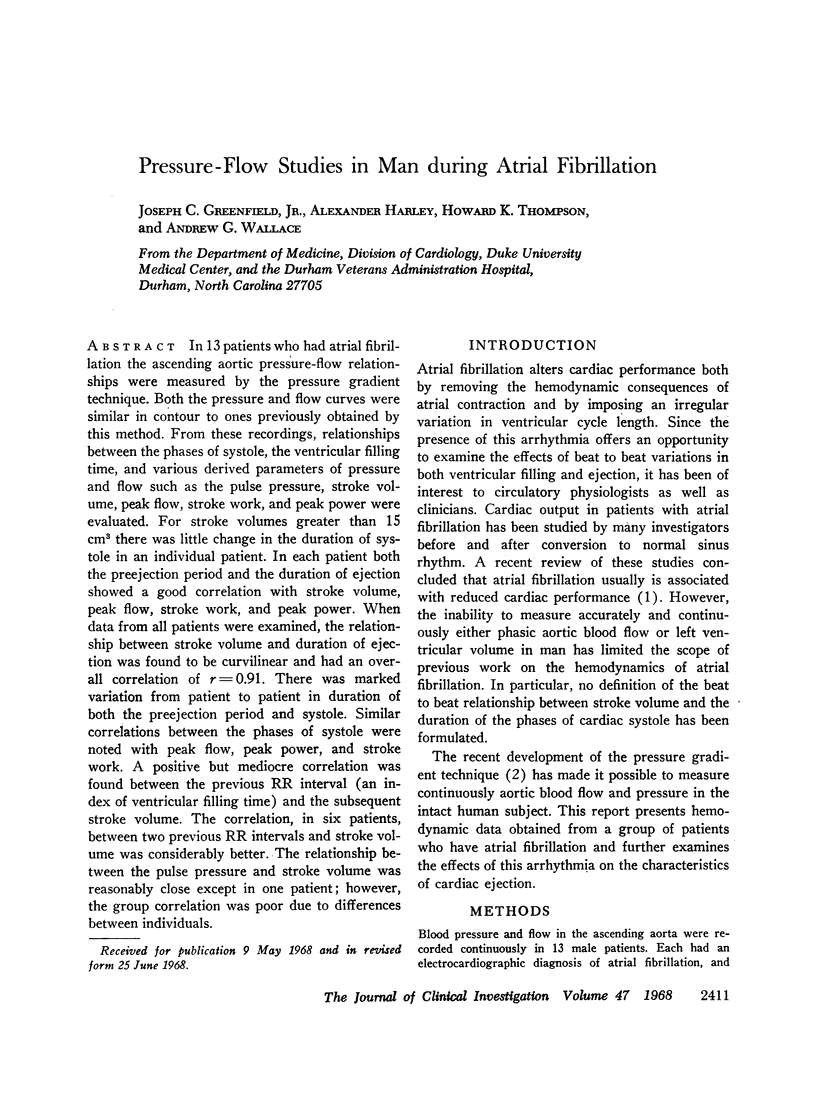
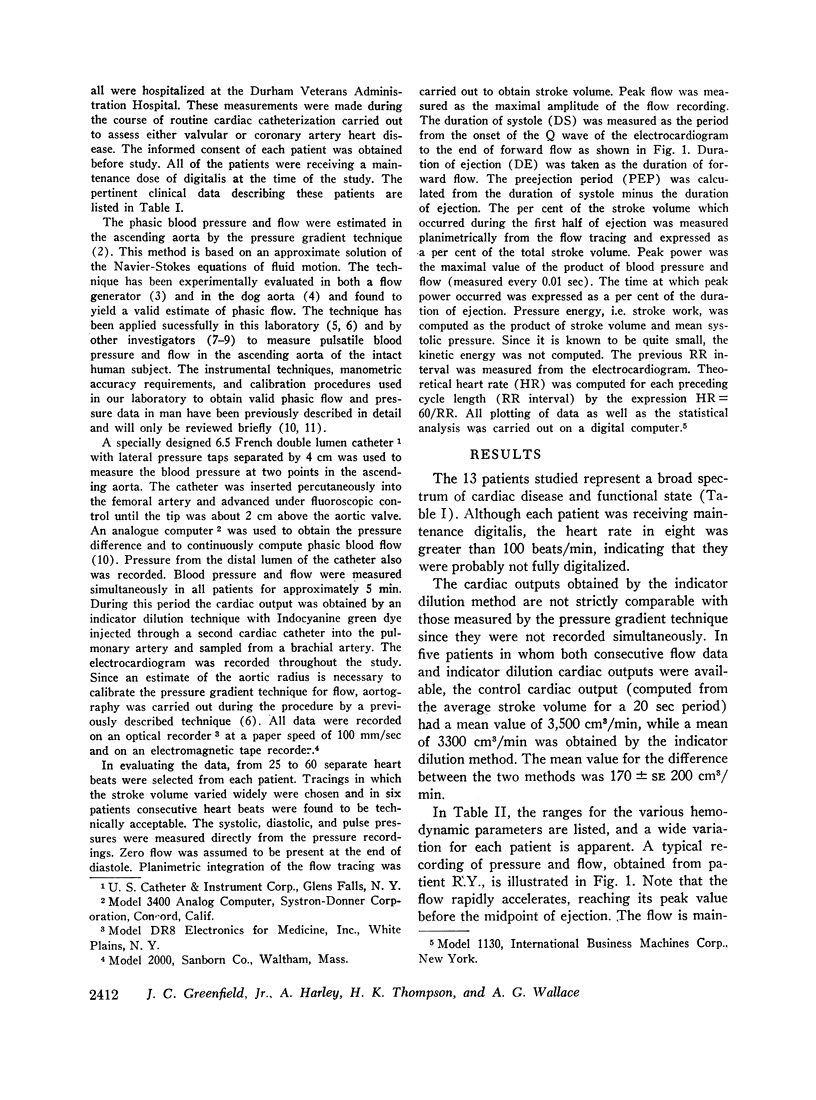
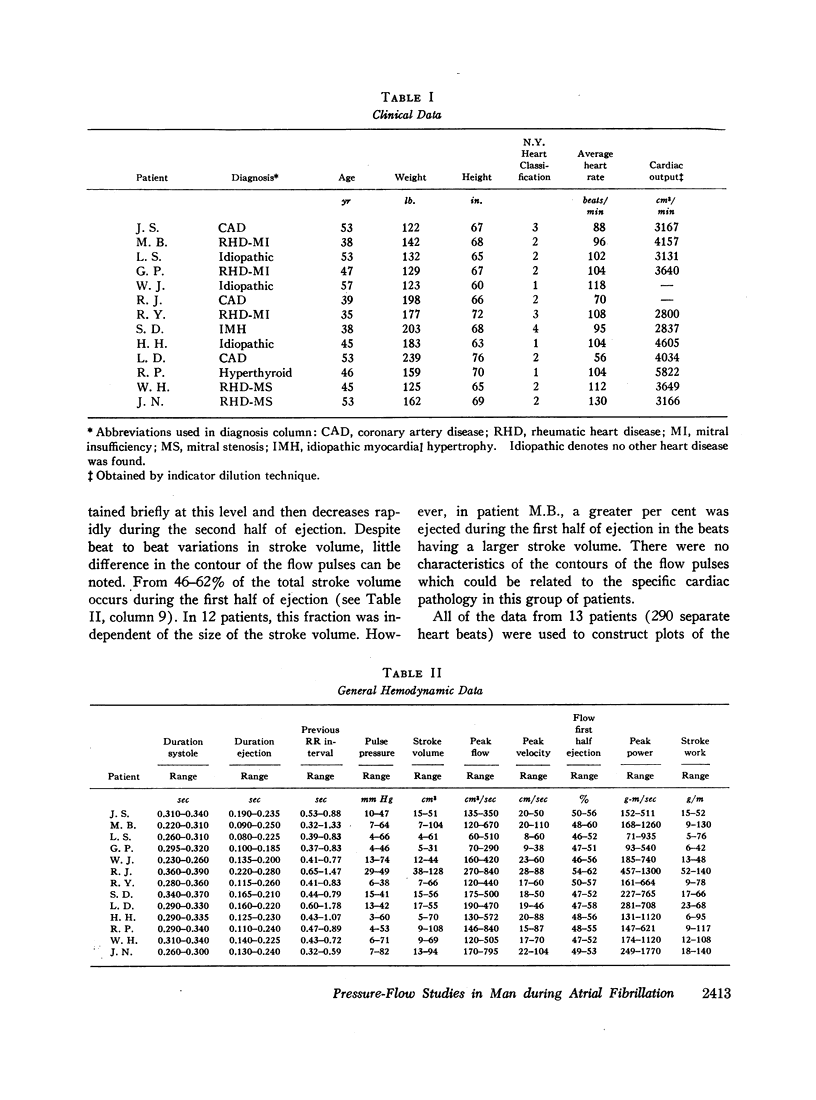
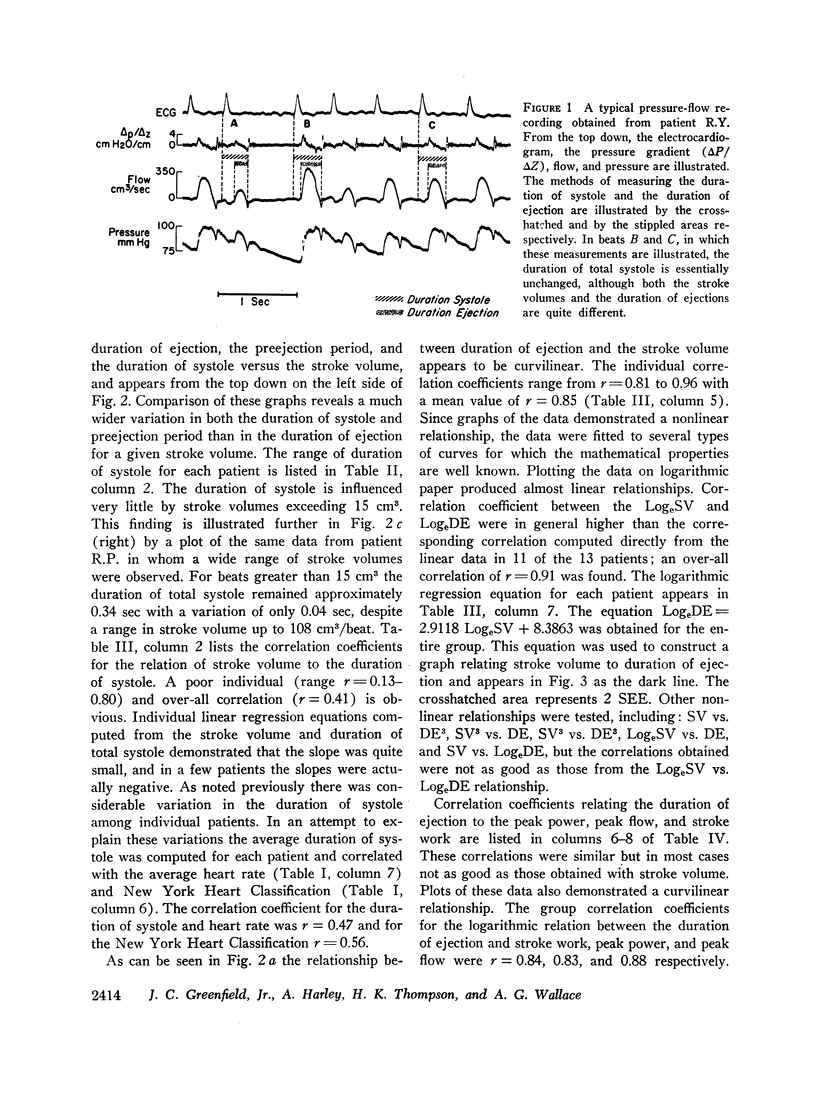
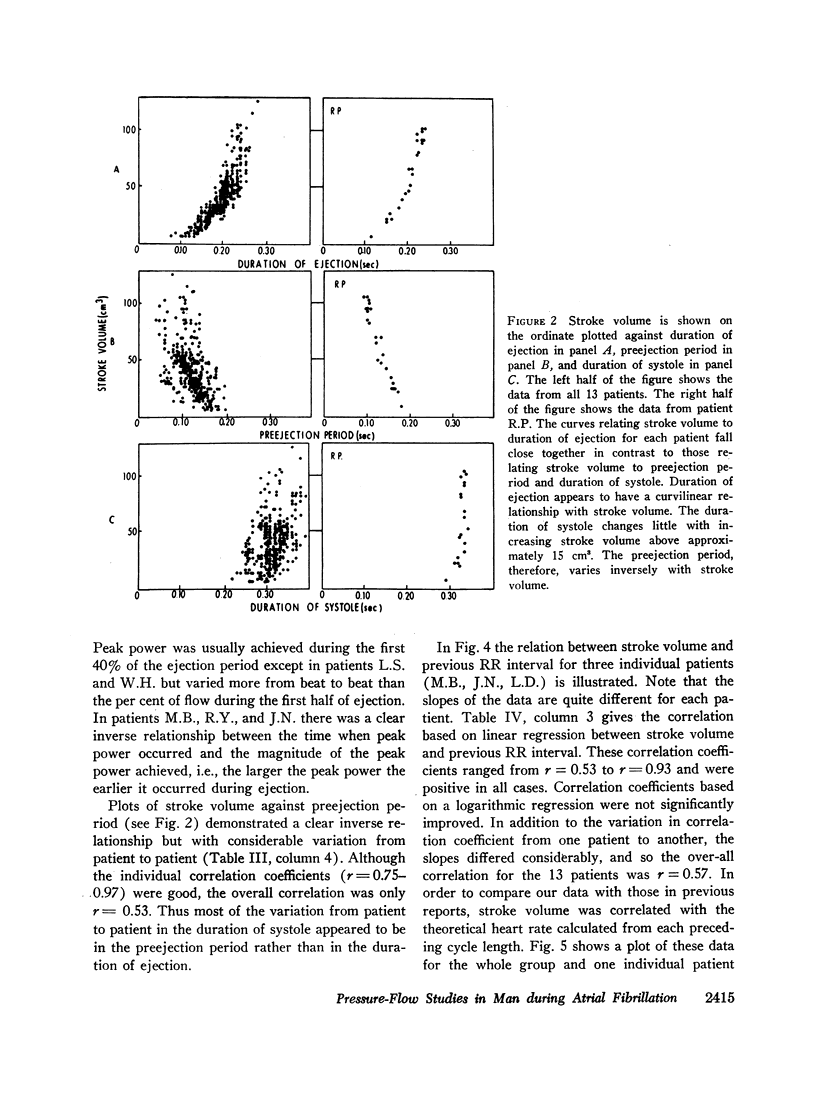
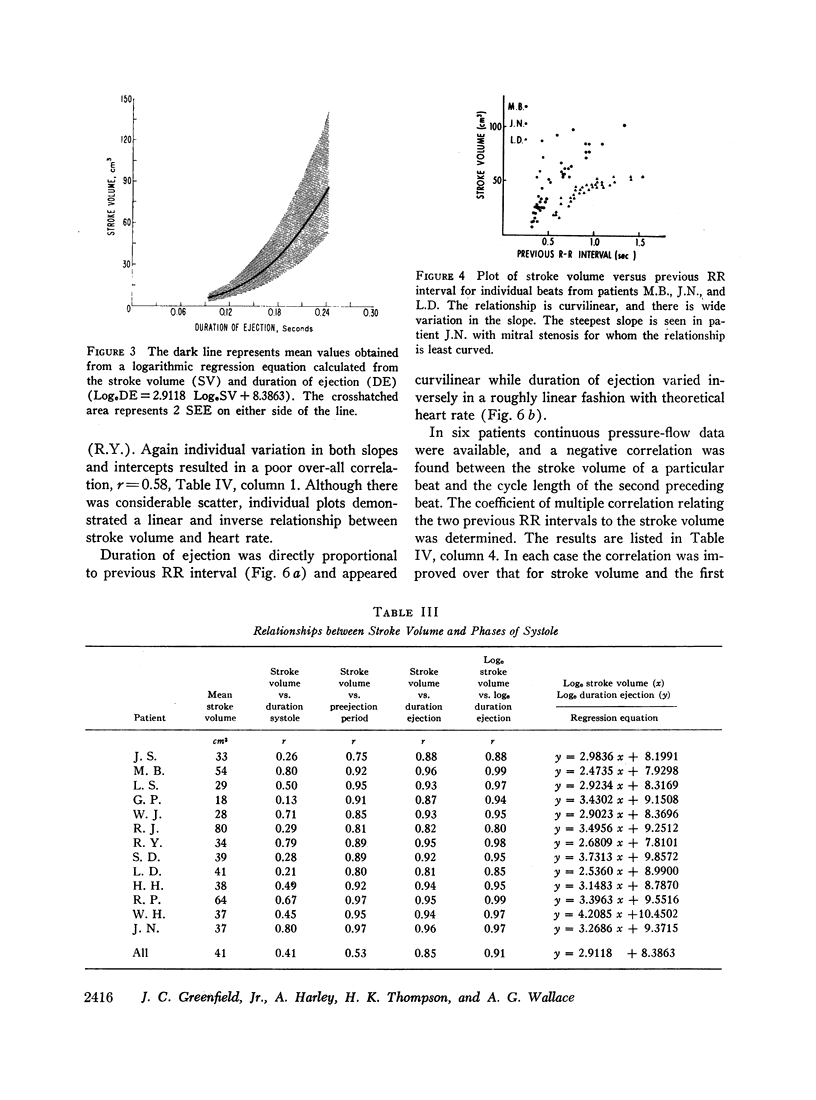
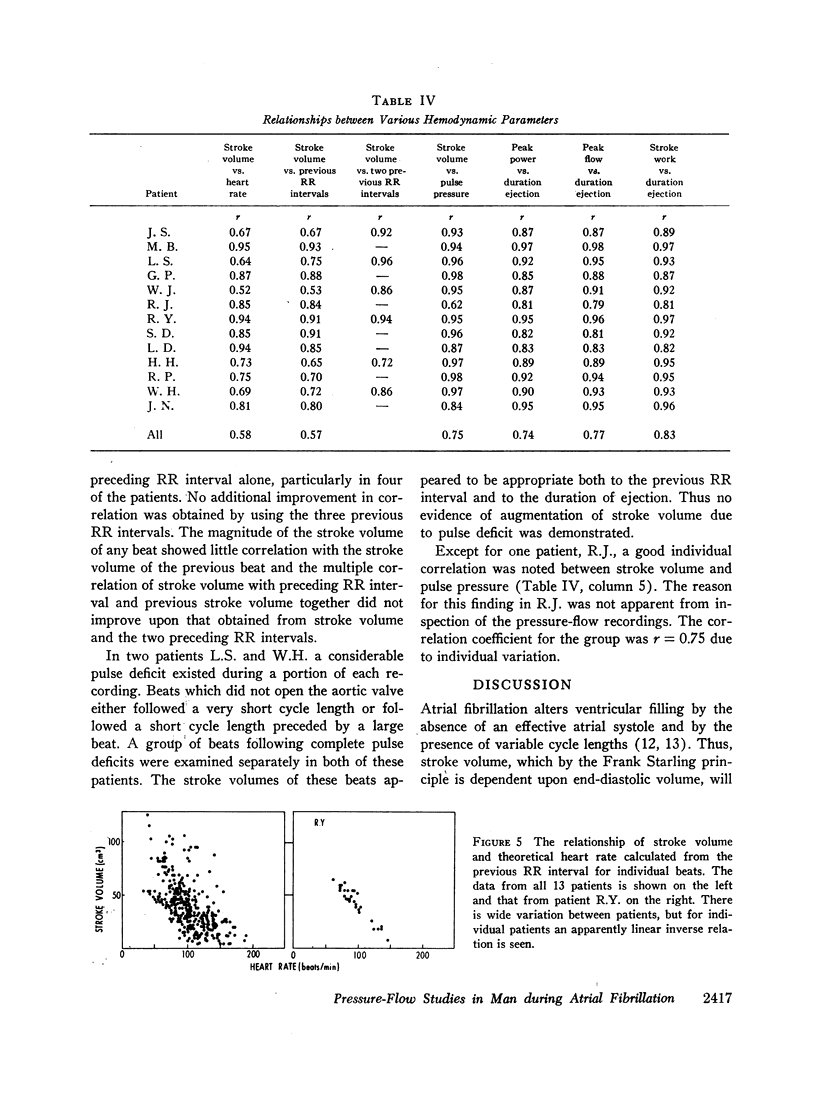
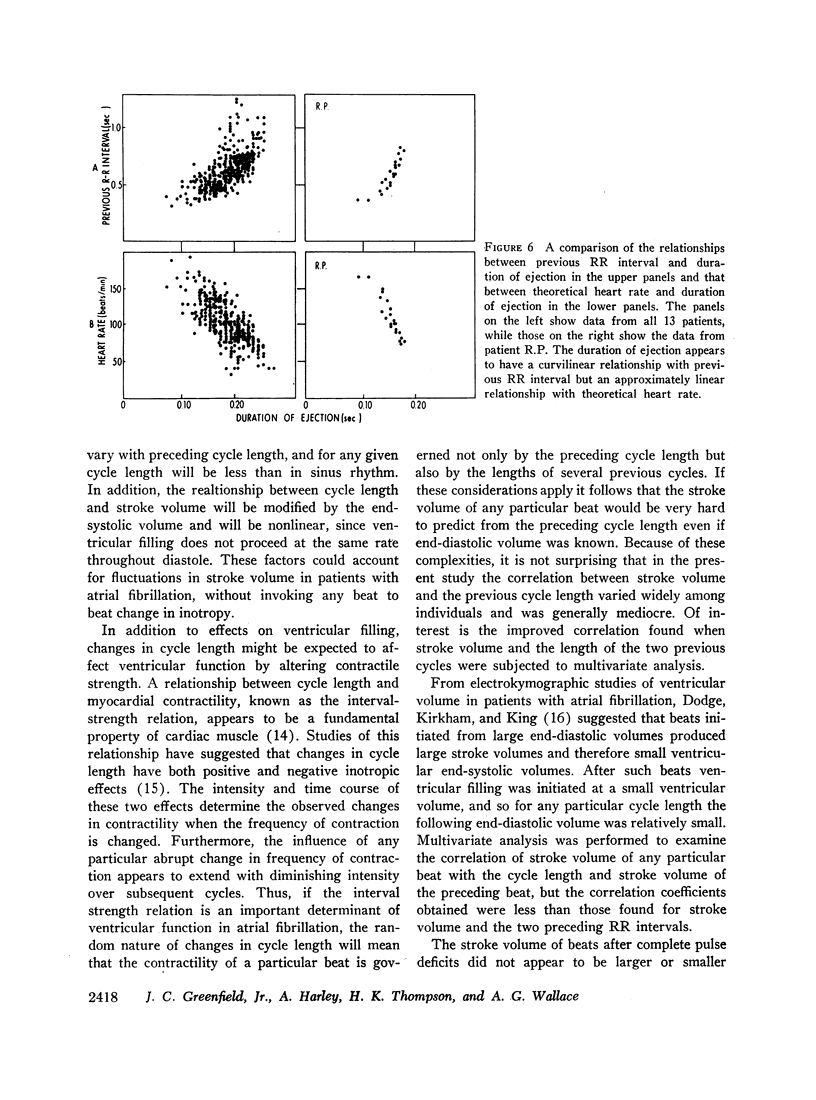
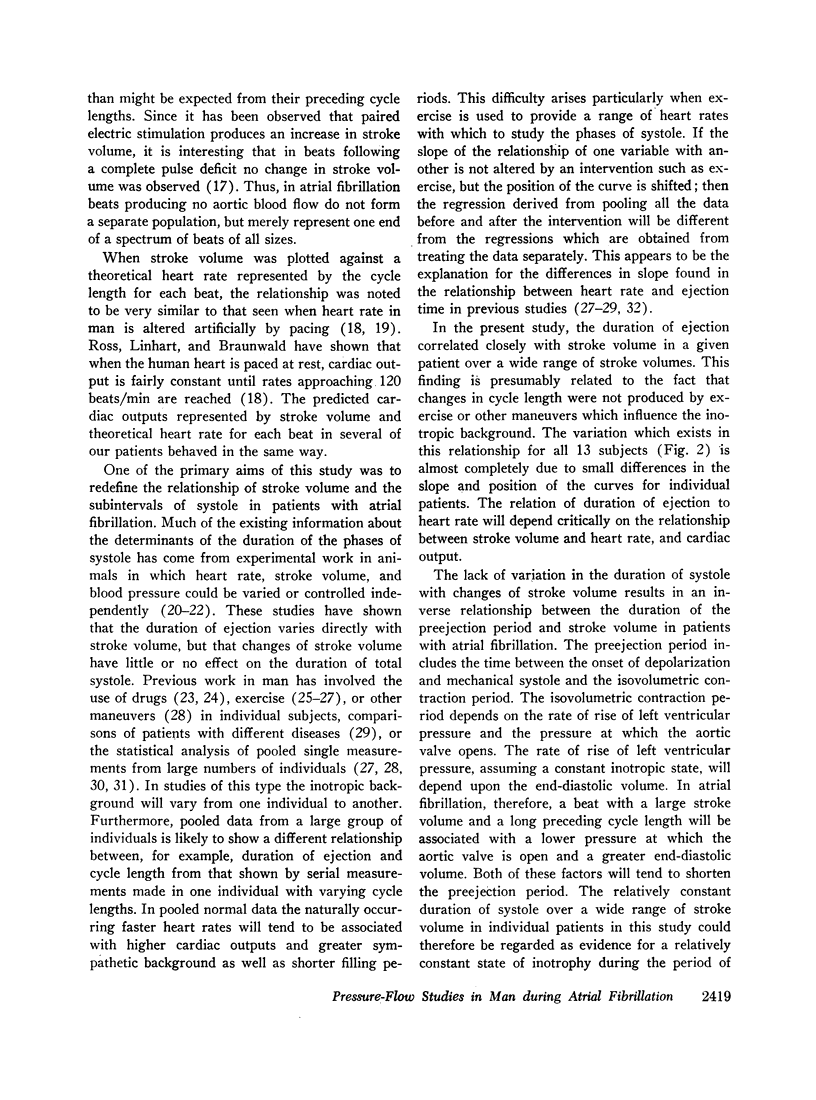
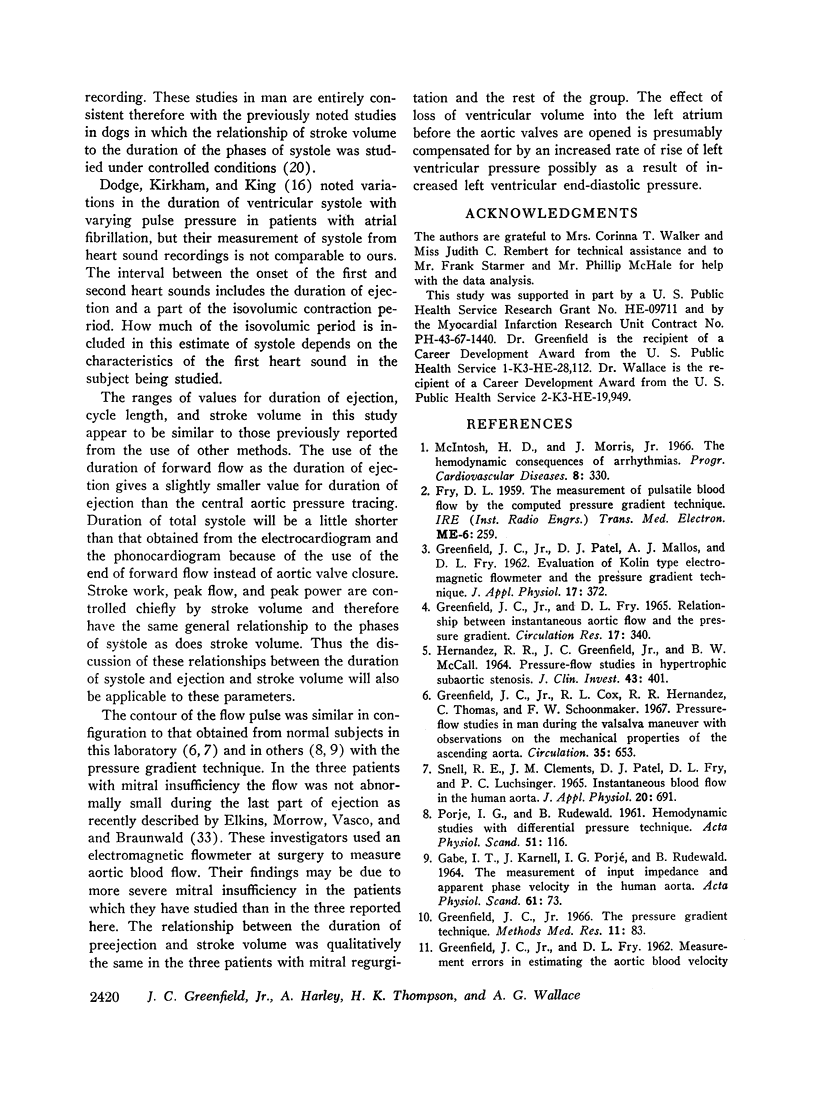
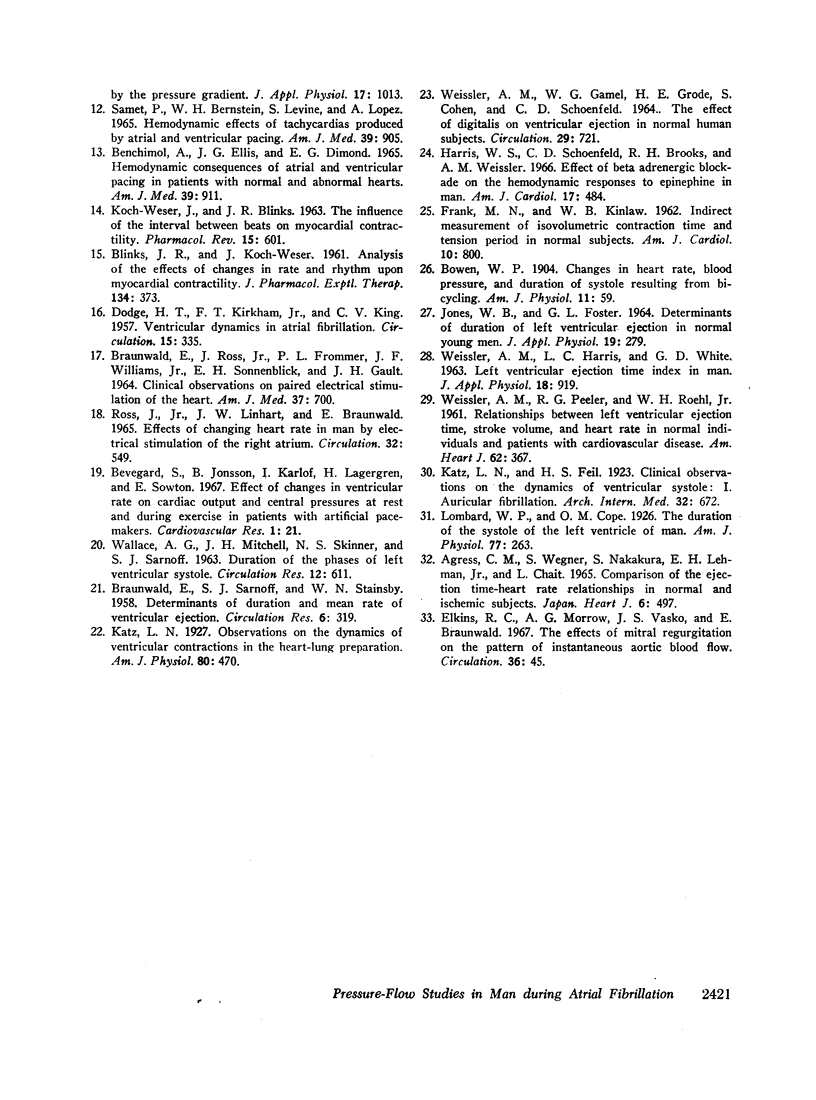
Images in this article
Selected References
These references are in PubMed. This may not be the complete list of references from this article.
- Agress C. M., Wegner S., Nakakura S., Lehman E. H., Jr, Chait L. Comparison of the ejection time-heart rate relationships in normal and ischemic subjects. Jpn Heart J. 1965 Nov;6(6):497–510. doi: 10.1536/ihj.6.497. [DOI] [PubMed] [Google Scholar]
- BLINKS J. R., KOCH-WESER J. Analysis of the effects of changes in rate and rhythm upon myocardial contractility. J Pharmacol Exp Ther. 1961 Dec;134:373–389. [PubMed] [Google Scholar]
- BRAUNWALD E., ROSS J., Jr, FROMMER P. L., WILLIAMS J. F., Jr, SONNENBLICK E. H., GAULT J. H. CLINICAL OBSERVATIONS ON PAIRED ELECTRICAL STIMULATION OF THE HEART. EFFECTS ON VENTRICULAR PERFORMANCE AND HEART RATE. Am J Med. 1964 Nov;37:700–711. doi: 10.1016/0002-9343(64)90019-1. [DOI] [PubMed] [Google Scholar]
- BRAUNWALD E., SARNOFF S. J., STAINSBY W. N. Determinants of duration and mean rate of ventricular ejection. Circ Res. 1958 May;6(3):319–325. doi: 10.1161/01.res.6.3.319. [DOI] [PubMed] [Google Scholar]
- Benchimol A., Ellis J. G., Dimond E. G. Hemodynamic consequences of atrial and ventricular pacing in patients with normal and abnormal hearts. Effect of exercise at a fixed atrial and ventricular rate. Am J Med. 1965 Dec;39(6):911–922. doi: 10.1016/0002-9343(65)90113-0. [DOI] [PubMed] [Google Scholar]
- Bevegård S., Jonsson B., Karlöf I., Lagergren H., Sowton E. Effect of changes in ventricular rate on cardiac output and central pressures at rest and during exercise in patients with artificial pacemakers. Cardiovasc Res. 1967 Jan;1(1):21–33. doi: 10.1093/cvr/1.1.21. [DOI] [PubMed] [Google Scholar]
- DODGE H. T., KIRKHAM F. T., KING C. V. Ventricular dynamics in atrial fibrillation. Circulation. 1957 Mar;15(3):335–347. doi: 10.1161/01.cir.15.3.335. [DOI] [PubMed] [Google Scholar]
- Elkins R. C., Morrow A. G., Vasko J. S., Braunwald E. The effects of mitral regurgitation on the pattern of instantaneous aortic blood flow. Clinical and experimental observations. Circulation. 1967 Jul;36(1):45–53. doi: 10.1161/01.cir.36.1.45. [DOI] [PubMed] [Google Scholar]
- FRANK M. N., KINLAW W. B. Indirect measurement of isovolumetric contraction time and tension period in normal subjects. Am J Cardiol. 1962 Dec;10:800–806. doi: 10.1016/0002-9149(62)90174-1. [DOI] [PubMed] [Google Scholar]
- GABE I. T., KARNELL J., PORJE I. G., RUDEWALD B. MEASUREMENT OF INPUT IMPEDANCE AND APPARENT PHASE VELOCITY IN THE HUMAN AORTA. Acta Physiol Scand. 1964 May-Jun;61:73–84. doi: 10.1111/j.1748-1716.1964.tb02944.x. [DOI] [PubMed] [Google Scholar]
- GREENFIELD J. C., Jr, FRY D. L. Measurement errors in estimating aortic blood velocity by pressure gradient. J Appl Physiol. 1962 Nov;17:1013–1019. doi: 10.1152/jappl.1962.17.6.1013. [DOI] [PubMed] [Google Scholar]
- GREENFIELD J. C., Jr, PATEL D. J., MALLOS A. J., FRY D. L. Evaluation of Kolin type electromagnetic flowmeter and the pressure gradient technique. J Appl Physiol. 1962 Mar;17:372–374. doi: 10.1152/jappl.1962.17.2.372. [DOI] [PubMed] [Google Scholar]
- Greenfield J. C., Jr, Cox R. L., Hernández R. R., Thomas C., Schoonmaker F. W. Pressure-flow studies in man during the Valsalva maneuver with observations on the mechanical properties of the ascending aorta. Circulation. 1967 Apr;35(4):653–661. doi: 10.1161/01.cir.35.4.653. [DOI] [PubMed] [Google Scholar]
- Greenfield J. C., Jr, Fry D. L. Relationship between instantaneous aortic flow and the pressure gradient. Circ Res. 1965 Oct;17(4):340–348. doi: 10.1161/01.res.17.4.340. [DOI] [PubMed] [Google Scholar]
- HERNANDEZ R. R., GREENFIELD J. C., Jr, MCCALL B. W. PRESSURE-FLOW STUDIES IN HYPERTROPHIC SUBAORTIC STENOSIS. J Clin Invest. 1964 Mar;43:401–407. doi: 10.1172/JCI104924. [DOI] [PMC free article] [PubMed] [Google Scholar]
- Harris W. S., Schoenfeld C. D., Brooks R. H., Weissler A. M. Effect of beta adrenergic blockade on the hemodynamic responses to epinephrine in man. Am J Cardiol. 1966 Apr;17(4):484–492. doi: 10.1016/0002-9149(66)90238-4. [DOI] [PubMed] [Google Scholar]
- JONES W. B., FOSTER G. L. DETERMINANTS OF DURATION OF LEFT VENTRICULAR EJECTION IN NORMAL YOUNG MEN. J Appl Physiol. 1964 Mar;19:279–283. doi: 10.1152/jappl.1964.19.2.279. [DOI] [PubMed] [Google Scholar]
- KOCH-WESER J., BLINKS J. R. THE INFLUENCE OF THE INTERVAL BETWEEN BEATS ON MYOCARDIAL CONTRACTILITY. Pharmacol Rev. 1963 Sep;15:601–652. [PubMed] [Google Scholar]
- McIntosh H. D., Morris J., Jr The hemodynamic consequences of arrhythmias. Prog Cardiovasc Dis. 1966 Jan;8(4):330–363. doi: 10.1016/s0033-0620(66)80010-5. [DOI] [PubMed] [Google Scholar]
- Ross J., Jr, Linhart J. W., Brauwald E. Effects of changing heart rate in man by electrical stimulation of the right atrium. studies at rest, during exercise, and with isoproterenol. Circulation. 1965 Oct;32(4):549–558. doi: 10.1161/01.cir.32.4.549. [DOI] [PubMed] [Google Scholar]
- Samet P., Bernstein W. H., Levine S., Lopez A. Hemodynamic effects of tachycardias produced by atrial and ventricular pacing. Am J Med. 1965 Dec;39(6):905–910. doi: 10.1016/0002-9343(65)90112-9. [DOI] [PubMed] [Google Scholar]
- Snell R. E., Clements J. M., Patel D. J., Fry D. L., Luchsinger P. C. Instantaneous blood flow in the human aorta. J Appl Physiol. 1965 Jul;20(4):691–695. doi: 10.1152/jappl.1965.20.4.691. [DOI] [PubMed] [Google Scholar]
- WALLACE A. G., MITCHELL J. H., SKINNER N. S., SARNOFF S. J. Duration of the phases of left ventricular systole. Circ Res. 1963 Jun;12:611–619. doi: 10.1161/01.res.12.6.611. [DOI] [PubMed] [Google Scholar]
- WEISSLER A. M., GAMEL W. G., GRODE H. E., COHEN S., SCHOENFELD C. D. THE EFFECT OF DIGITALIS ON VENTRICULAR EJECTION IN NORMAL HUMAN SUBJECTS. Circulation. 1964 May;29:721–729. doi: 10.1161/01.cir.29.5.721. [DOI] [PubMed] [Google Scholar]
- WEISSLER A. M., HARRIS L. C., WHITE G. D. LEFT VENTRICULAR EJECTION TIME INDEX IN MAN. J Appl Physiol. 1963 Sep;18:919–923. doi: 10.1152/jappl.1963.18.5.919. [DOI] [PubMed] [Google Scholar]
- WEISSLER A. M., PEELER R. G., ROEHLL W. H., Jr Relationships between left ventricular ejection time, stroke volume, and heart rate in normal individuals and patients with cardiovascular disease. Am Heart J. 1961 Sep;62:367–378. doi: 10.1016/0002-8703(61)90403-3. [DOI] [PubMed] [Google Scholar]



